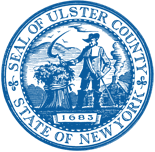For up to date road-stream crossing data and management planning, visit the Ulster County Road-Stream Crossings (Culvert) Assessments hub, which includes an interactive web map and links to the NAAC assessments.
Streams and roads are both linear networks and where they intersect, a structure carries the road over the stream. These structures are called road stream crossings (RSX). As an integral part of our transportation networks, RSX should be constructed to not alter the natural shape of the stream. When roads and streams cannot peacefully co-exist, flooding is more likely to occur, along with increased maintenance and significant disruptions to aquatic ecosystems.
Ulster County is committed to planning for transportation infrastructure that is safe and storm-resilient, as part of this goal, Ulster County Department of the Environment has completed multiple road stream crossing (RSX) assessment projects.
From 2016 to 2018, Ulster County Department of the Environment, partly funded by a grant from the New York State Environmental Protection Fund through the Hudson River Estuary Program of the New York State Department of Environmental Conservation, assessed all RSX on County-owned roads, and all town roads in the Sawkill Watershed (excepting the crossings in the Ashokan Watershed which were assessed by the Ashokan Watershed Stream Management Program- AWSMP). This assessment examined aquatic passability using the protocol developed by the North Atlantic Aquatic Connectivity Collaborative (NAACC).
From 2019 to 2020, Ulster County Department of the Environment, in partnership with Cornell Cooperative Extension of Ulster County AWSMP, assessed all RSX (County and Town roads) in the towns of Kingston, Saugerties, and Woodstock, as well as County RSX in the Lower Esopus Watershed. This project was funded by NEIWPCC and the NYSDEC Hudson River Estuary Program. These assessments utilized an expanded RSX assessment protocol called MOSCAP, or Multi-Objective Stream Crossing Assessment Protocol. MOSCAP was developed by the AWSMP and examines geomorphic compatibility, structural condition, aquatic passage, and flood risk. Project deliverables included detailed maps of RSX, a full dataset of RSX for each town and the County, and RSX management plans that work in concert with the dataset. Given the NAACC component, each crossing has an online entry detailing structural specifications, aquatic passage data, and photos.
The NAACC is a participatory network of practitioners united in their efforts to enhance aquatic connectivity. The NAACC project will support planning and decision making by providing tools and information on where restoration projects are likely to have the greatest aquatic connectivity benefits and resiliency benefits. All data collected is available for viewing and download at: https://naacc.org
Road Stream Crossing Assessments
The assessment portion of these RSX projects begins with a desktop analysis in GIS to locate streams, where streams cross a road, a point is created and named, thus generating a digital RSX that is then followed up with a field visit. During the field visit, the field crew walks upstream taking measurements and noting geomorphic indicators such as erosion and deposition. The road and structure are then examined, things like; slope, dimensions, depth, and condition are entered as data. Photos are taken, the outlet and downstream are examined, then all this information is submitted to the online NAACC database. Later, the data are downloaded and combined to give the crossing a weighted score, and when compared to other crossings can be prioritized.

